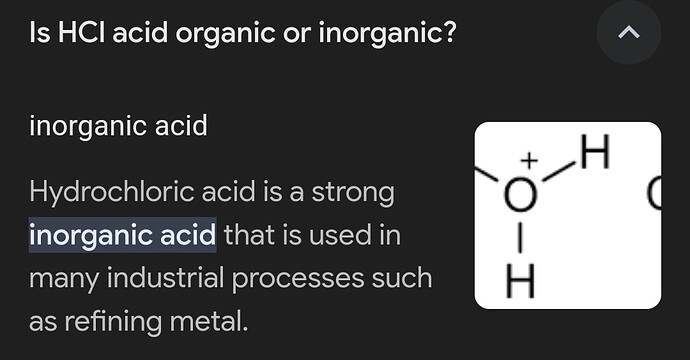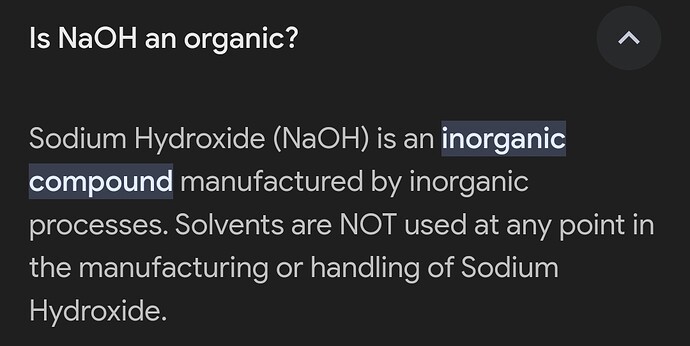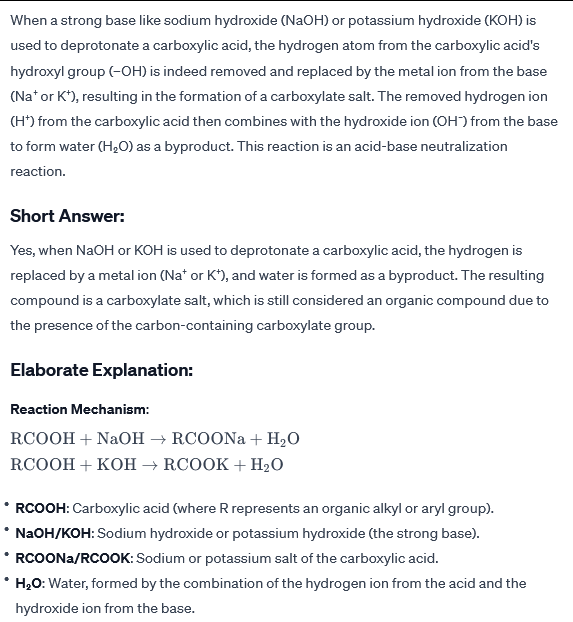Title might be changed to “ Deprotonated Water Extraction”
Brother must be scared every time someone offers him a pretzel. “Be careful, that’s synthetic! Who knows what dangers lie in it’s tasty brown exterior!?”
So what you are saying is the NaCl that is created during the final reaction to strip the metal back off by putting a hydrogen back on and is left behind in the water layer but wasn’t put in the reaction at any point in the process other than through acid-base chemistry, whereby an acid reacted with a base to form salt and water, is just a figment of imagination? FML… Go back to school. ![]()
![]()
The purple powder was dried at 150f under a hard vacuum for 24hr. How is the COO- floating around in water that is not in the mixture (it is a dehydrated dry powder)? Once you remove all of the solvents (water) you are left with a carboxylic salt with the metal attached to the molecule.
I’m interested in how you see NaOH or HCl as organic molecules…
With the base-acid process you are literally pulling a hydrogen (from the -COOH group but really we can say from anywhere on the molecule one hydrogen is lost to the base (-OH) and forms H2O (H + OH → H2O), replacing the hydrogen with a metal.
As a part of acid base chemistry you are also putting the metal somewhere on the molecule as you remove the hydrogen.
What about side chain reactions from the terpenes and other cannabinoids?
No reaction is 100% perfect, usually 85-95% at best in each phase so you can pretty much guarantee that acid, base, initial crude, final isolate, and side chain byproducts are all together in a soup at various ratios. You can use a hydrocarbon to do water washes but that is still not perfect.
I feel the only reason anyone would argue that using drain cleaner makes organic molecules is because they must be working a similar process and need this process to look good and safe ($0.02). Just some basic guidelines, don’t need people dumping toluene or other solvents down the drain so to not pay dumping fees.
I would like to see test results showing all the byproducts and what not are removed from the final product. Interested in seeing those metal content, Na, K, solvents, etc. before even considering the safety of the product. Not too big on the method of looking at it and saying it’s good without any testing.
It’s easy to make a safe product with hydrocarbon in a certified machine. Just drop the T and collect the goods. No stripping of hydrogen and adding of metals to anything to make it possible.
What’s funny is, I do have a shit ton of allergies, most I should avoid the rest of my life, and I’m pointing out basic properties of the process only to be told “don’t worry it’s safe”. Sorry but no.
Prove you are right without shit talking and I’ll pat you on the back and scream it from the rooftop.
Though, I have a really hard time believing the chatgpt is wrong about everything including very basic physics and chemistry or definitions there of.
Try not to take things out of context… Only reactions that remove an atom and replace it with an inorganic atom are considered semi-synthetic. Such as this topic base-acid extraction.
Additions and removal of acid such as HCl (common salt form) to an existing molecule without altering the molecule, such as caffeine freebase and caffeine hcl, is the alternate possibility that does not create a new molecule. This is a better example of when two molecules are together but not bonded as like with carboxylic acids + bases.
The caffeine is not altered, isomerized, nor atoms removed or replaced. Just HCl along with it.
Zack, I know you are trying your best.
Take a close look at water and see if two or three years of study brings you up to date on water and its natural ionization states.
Do you think you can write the number which represents the number of molecules in a liter of water?
Ask AI to print it out in text form.
Enjoy…
… don’t need ai for that…
Contemplate that number 10 ^ 23 times 55.
Now look at the ionization constant…and come up with the concentration of ionized H+ and OH- in a liter of water.
Then think about h-bonded networks of H2O (N-mer complexes) interacting with the number of ionized forms of water at rates of 10 ^13 per mole per second. Trillions of Trillions of little fuckers jittering back and forth at room temp and not an “organic molecule” in sight. Is this your setting for semisynthesis?
OK…now think of such an liquid material having fallen out of space onto earth and interacting with dirt for 2-3 billion years…what do you have?
You seem clever and you have a natural curiosity …so regardless of education…you are a natural scientist.
It is only a matter of communication in a form that others understand. Capisce? Using AI as a translator doesn’t exactly help.
This all really just circles back to reaction efficiency…
Its never going to be 100% so there will be roughly a 95-98% cloud of each interacting with each other at a rate of say about 85% interference which would bring the overall reaction down to about 80% efficient. Be your conditions or the gods of chemistry then decide how much of what gets done.
The self ionization of water is an interesting aspect as it is a provider for side-chain reactions during the process. In general, you can ignore the process for general calculations but when you want to know everything - lots of calculations to do.
This then comes back to the safety issue… Is it really “safe” ? Not gonna go on assumptions personally, need to see that data!
Are you saying don’t drink the water because the hydrogen originated in the Big Bang?
If you made a 1 M solution of HCl in water what is the probability of any hydronium ion coming from the added HCl?
“Given the high concentration of HCl (1 M), the contribution of hydronium ions from HCl dissociation vastly outweighs the contribution from water’s autoionization. Therefore, practically all the hydronium ions in the solution can be considered to come from HCl, making the probability extremely close to 100%.”
Kinda spiraling now off topic no?
The main point was whenever you react a carboxylic acid with NaOH or KOH you put the metal on the carboxylic acid in place of the hydrogen. Then later you re-introduce hydrogen from an acid source (inorganic material) that swaps place with the metal forming salt. This is a semi-synthetic process as you start with a natural plant molecule, strip hydrogen, add metal, strip metal, and reintroduce new source hydrogen.
It is a simple acid-base reaction whereby the carboxylic salt is the conjugate base of the carboxylic acid and the water produced is the conjugate acid through self-ionization. Then when you react the conjugate base with an acid like HCl, then it reacts as expected (H3O+) and pulls the metal back off the molecule where it then rebinds with the Cl to form NaCl. The H3O+ provided by the water in comparison to the acid is very small.
https://doi.org/10.1073/pnas.1312350110
Probing the mechanisms of proton transfer in liquid water
I really have no idea! Hmmm…
Some lit suggests:
The defect can become delocalized over several hydrogen bonds owing to quantum fluctuations .
(The nature of the hydrated excess proton in water | Nature)
Perhaps precipitating cannabinoates with HCl is a “high wire act”.
Nope.
No need for a AI, but slow down and look at the question….
Avogadro’s number is for a mol of water….not a liter…
The water has a molecular weight of 18. The liter of water has 1000 grams. The number of moles is 1000/18 = 55.556 moles. The number of molecules is therefore 6.022 * 10^23 * 55.556 = 3.346 * 10^25 molecules. ![]()
Basic high school chemistry… bring everything to the same units: do basic math.
After all, since we are looking at molecular count, wouldn’t it be prudent to do everything in molecular weight (mols) ?
What is interesting about that number…is that if you have or can show 2.5% H2O in your crystalline THCA you have a. Semi-hydrate (2 R-COOH / 1 H20).
Yep, that stuff gets everywhere…
I believe the contention was more of
Allowed in the processing of (some) “USDA Organic” products.
Eg: https://www.ams.usda.gov/sites/default/files/media/SodiumHydroxideTR_05082020.pdf
Not so for HCl?
So how many trillion molecules of semisynthetic Hydronium are present in a glass of water?
Think you are getting a bit carried away with the semantics here…
Again, the point was, no matter what, when you react a carboxylic acid (THCa/CBDa/etc) with a base such as NaOH or KOH, the metal in fact gets put on the natural molecule.
I have personally done over a hundred reactions using acids/bases & cannabinoids (neutral & acidic) and tracked the process with my GC taking samples every 10 minutes. We had an in-house HPLC for acidic testing also, but ultimately KCA for final approval.
When you weigh in 100g of 85% CBDa crude and calculate the required NaOH to go with it and weigh the output it is no longer 100g after recovering the solvents. It in fact goes up by the amount of the sodium by the molecules which reacted (sodium [11] weighs more than hydrogen [1]). Interestingly, some of the neutral molecules can get carried along by the carboxylic salt (must be electron cloud shit & like dissolves like).
You can stop half way through the “extraction” process and dry the salt. That is what the purple powder is I have posted about that is water soluble.
You can clearly track what goes where when you run the math and do some calcs. There is definitely a metal that gets attached to the molecule in place of a hydrogen that it came with. At this point and any forward the molecule is semi-synthetic, even if the hydrogen gets replaced, which obviously won’t be from a natural source but really that doesn’t matter at this point. It is already semi-synthetic when you attached the metal.

Also, water is inorganic so everything about it was kinda moot.
Stick with hydrocarbons - they are organic. ![]()
“The Tao gave birth to one” and hydrogen gave birth to both carbon and oxygen…are you denying “homoousios”…
A heretic no less?
What about the metal vape cart crisis?
Zach…just adding a bit of sardonic humor.
I’m guessing you have your own lab?
I’d get rid of the purple CBDA…
Obviously if you make a salt of an acid …it does have the same weight after evaporating solvent. You do understand that you can in fact make the phenolate sodium salts as well. There is a patent on process. Nobody tries to vaporize the salts. Why would you even try to isolate sodium salts of cannabinoic acids? Of course what you are saying is true…but that is NOT using base extraction to make neutral cannabinoic acids. You are disregarding the second half of the process! If I sent you sodium acetate crystal how would you devise a sop to recover acidic acid with no residual sodium? Have you read any of the patents closely? They can be subtle as many are designed and worded to obfuscate what they are legally describing.
I think you are smart enough to know what you don’t know.
And yes , if you make crystalline Metal Salts of organic acids …you will find the stochiometric mass of counter ion upon analysis depending on which variation of salt you prefer to make. But no one in there right mind is going to try to vape it.
There is no reason to publish photos of the purple material.
You’re good to go.



